Global and China Intelligent Cockpit Platform for Automobiles Industry Report, 2020
Cockpit electronic system refers to a complete set of system composed of center console, full LCD dashboard, HUD, rear seat entertainment system, smart audio, telematics module, streaming media rearview mirror and telematics system.
Based on cockpit domain controller, intelligent cockpit system as a foundation of human-car interaction and V2X, provides intelligent interaction, intelligent scenarios and personalized services beyond capabilities of a cockpit electronic system, through a unified software and hardware platform.
Intelligent cockpit platform is a software and hardware architecture enabling sub-systems and features of a smart cockpit. It consists of hardware and software parts: hardware part is a hardware platform comprised of domain controllers and chips; software part refers to a software platform built by operating system, Hypervisor, middleware and support tools.
With advances in technologies about chip, software, among others, one-core multi-screen multi-system integrated cockpit platform as a way to integrate systems, cut costs and meet needs for multi-screen interconnection, intelligent interaction and intelligent driving capabilities that an usual cockpit cannot provide, becomes a mainstay in next-generation cockpit.
Quite a few automakers have set about deploying smart cockpit system. Some already equip the system on their production vehicles. Examples include MBUX system mounted on 2018 Mercedes-Benz A Class, and C4-Alfus 2.0 and C4-Pro, two domain controller-based cockpit platforms co-developed by Neusoft and Intel and installed in 2019 models like Hongqi HS7 and EXCEED LX.
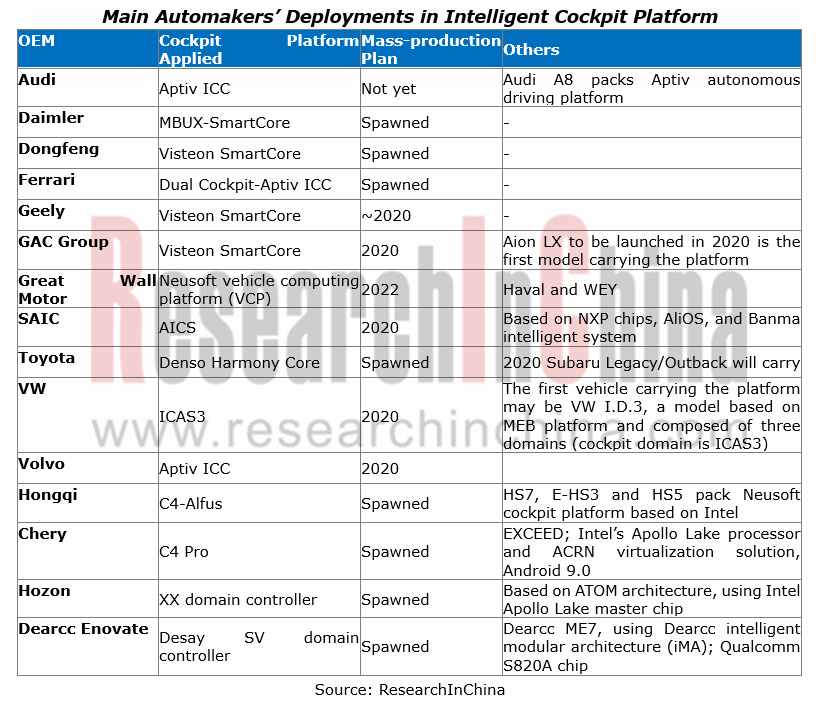
At CES 2020, Land Rover unveiled New Defender 90 and 110, the first ever vehicles to feature dual-modem, dual eSIM design for enhanced connectivity and functionality. Powered by the Qualcomm Snapdragon S820Am Automotive Platform with the integrated Snapdragon X12 LTE Modem, the New Defender can download Software-Over-The-Air (SOTA) updates without interruption and while streaming music and apps through the vehicle’s new Pivi Pro infotainment system. The New Defender is also the first Land Rover vehicle to include a domain controller that consolidates a number of Advanced Driver Assistance Systems (ADAS) and driver convenience functions built on top of the QNX Hypervisor.
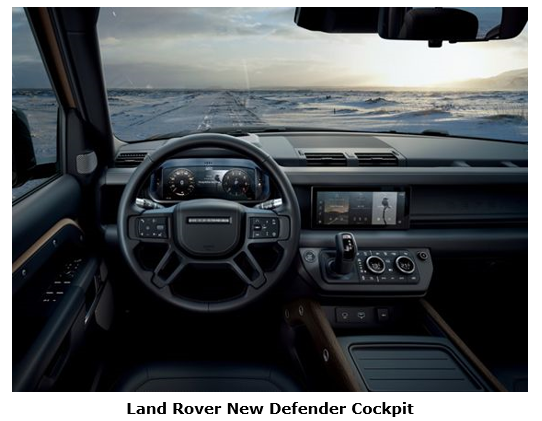
Intelligent cockpit hardware platform tends to be a fusion of more and more sub-systems and capabilities. How to well manage these sub-systems and functions rests with the upgrading of cockpit processor and smart cockpit software platform.
Smart cockpit hardware platform becomes ever more powerful in the process of integration
As the base of an intelligent cockpit hardware platform, cockpit domain controller integrated with multiple electronic control units (ECU) outperforms others in safety, size, power consumption, weight and cost, enabling seamless human-machine interaction in combination with interaction ecosystem.
All automotive system integrators are stepping up their efforts to deploy smart cockpit platform. Among them, Tier1 suppliers like Visteon, Aptiv, Neusoft and Desay SV have spawned intelligent cockpit platforms; Continental, Panasonic, Bosch, Samsung, Huawei and so forth have also rolled out their new-generation intelligent cockpit platforms. In the forthcoming years, competition in cockpit platform field will prick up.
Visteon currently leads the intelligent cockpit domain controller industry. Visteon SmartCore has found massive application in Mercedes-Benz MBUX system early in 2018. At CES 2020, Visteon showcased its newest SmartCore?, an intelligent cockpit platform which is integrated with the Tencent Auto Intelligence (TAI) system and first available to GAC Aion LX, a new BEV model to be launched in 2020. Moreover, Dongfeng and Geely are also partners of Visteon.
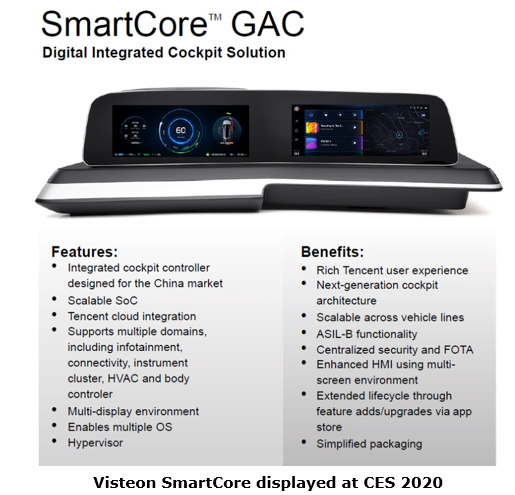
At the IAA 2019 in Frankfurt, Continental showcased the latest version of its Integrated Interior Platform (IIP), a new scalable cockpit platform favoring operating systems like QNX, Integrity, and Android. Continental plans to mass-produce the solution in 2021.
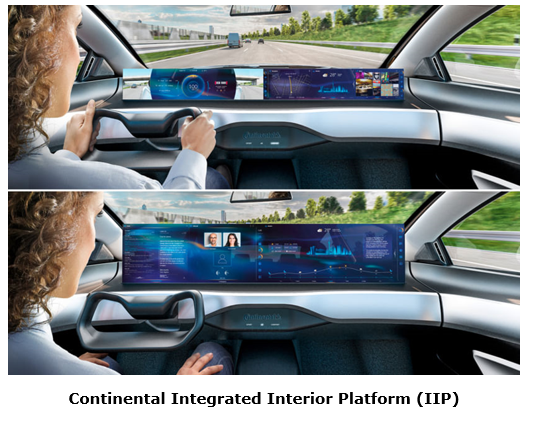
At CES 2020, Samsung Electronics unveiled Digital Cockpit 2020, which utilizes 5G to link features inside and outside the vehicle and provide connected experiences for drivers and passengers alike. Digital Cockpit 2020 is the third co-development between Samsung Electronics and Harman International, and combines Samsung’s telecommunications technologies, semiconductors and displays with HARMAN’s automotive expertise. Digital Cockpit 2020 incorporates eight displays inside the vehicle, as well as eight cameras. The solution utilizes Samsung Exynos Auto V9 SoC (System on Chip), a semiconductor for vehicle electronics, and Android 10, which allow for several features to be run at the same time. Besides, Samsung’s integrated IoT platform SmartThings can work in tandem with the revamped “Bixby in the car” to enhance connectivity by allowing the vehicle to actively communicate with the driver. Once the driver logs in using either facial recognition or a smartphone fingerprint reader, the Center Information Display can be used to show the driver’s schedule and a range of other information. Unlike the 2019 Digital Cockpit, the 2020 solution allows for connections to be made wirelessly.
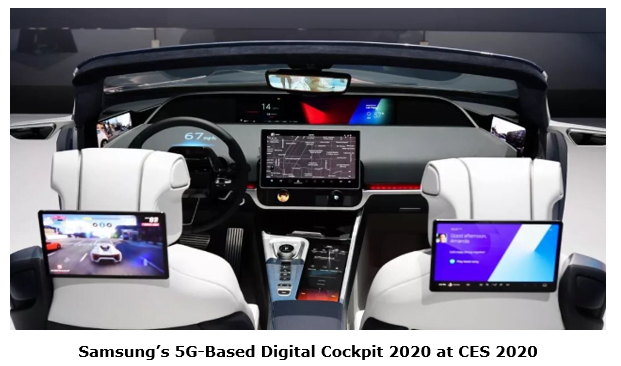
Panasonic Automotive revealed its latest fully connected eCockpit concept at CES 2020. The technology platform integrates Panasonic’s proprietary SkipGen 3.0 in-vehicle infotainment (IVI) system with Google’s Android Automotive OS running on Android 10. In the concept vehicle, SkipGen 3.0 is paired with the next generation cockpit domain controller, SPYDR 3.0. At the core, the single brain SPYDR 3.0 acts as a hypervisor and is capable of driving up to eleven displays.
As the kernel of cockpit domain controllers, cockpit processors are mainly supplied by Qualcomm, NXP, Intel, Renesas, Texas Instruments, NVIDIA, Allwinner, Samsung, MediaTek, Horizon Robotics, etc. Among them, Qualcomm, Intel and Renesas are the most competitive market players by virtue of their bombshells -- Qualcomm 820a / 835A, Intel A3900 and Renesas R-Car H3 / M3. The major processor chips differ in fabrication processes, cores, and especially GPU computing power which determines the infrastructure level of the cockpit hardware platform.
Software platform becomes the focus of differentiation; Cockpit will be defined by software in future
In intelligent cockpit software platform, hypervisor and vehicle operating system are the most important components. Hypervisor allows multiple operating systems and applications to share hardware as a middle software layer that runs between the underlying physical server and the operating system.
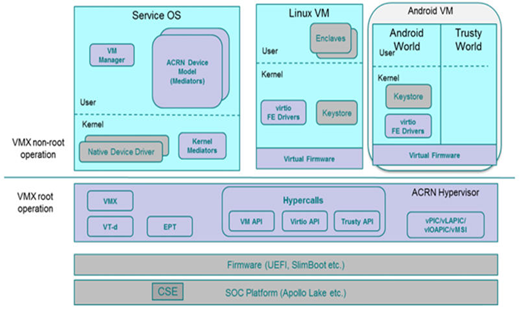
The prevailing automotive operating systems embrace QNX, Linux, Android, AliOS, etc., each of which has merits and demerits. Among them, QNX dominates the automotive cluster system market with high security; the open-source Linux has become the underlying system of custom-made operating systems; Android and AliOS are increasingly used by IVI systems due to rich application ecosystem.
Under the software-defined car trend, operating system is crucial to the intelligent connectivity layout of automakers, and the focus of the emerging system integrators’ deployments. Tesla's self-developed operating system made a success. In 2019, Volkswagen announced to lavish huge on R&D of VW.OS. Several Chinese emerging automakers follow Tesla to develop operating systems by themselves. Yet, all Japanese automakers support AGL in which China-based SITECH also joined.
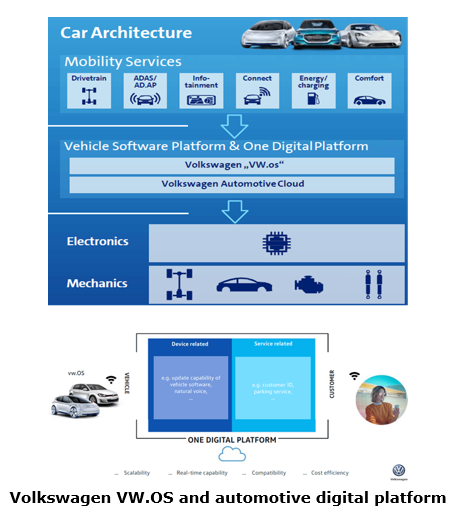
Also, the new suppliers such as Huawei, ZTE, Alibaba and Baidu have rolled out self-developed operating systems successively. In the future, there will be cut-throat competition in the automotive operating system market. At length, only two or three mainstream operating systems may survive. In fact, there are three mainstream cockpit operating systems for automakers: QNX, Android, and Linux (AGL).
Due to high requirements on safety, most clusters apply QNX. IVI, co-pilot entertainment and rear seat entertainment systems mostly make use of Android. Chinese brands like Geely, Changan, BYD, Dongfeng, Great Wall Motor and GAC are all based on Android, while SAIC prefers AliOS. Audi launched Android-based MIB3 system in 2019. BMW is extending the reach of seamless connectivity in its vehicles with the introduction of Android Auto? starting in mid-2020.
Because intelligent cockpit supports multiple operating systems such as QNX, Android and Linux simultaneously, hypervisors running directly on physical hardware have been widely used. As an intermediate software layer, hypervisors allow operating systems and applications to share hardware. Hypervisors not only coordinate access to hardware, but also impose protection between virtual machines. Common hypervisors include QNX Hypervisor, ACRN, COQOS Hypervisor, PikeOS, and Harman Device Virtualization.
QNX Hypervisor 2.0 uses BlackBerry’s 64-bit embedded operating system QNX SDP 7.0, allowing developers to unify multiple operating systems to a single computing platform or SoC chip. Operating systems such as QNX Neutrino, Linux, and Android are supported on BlackBerry QNX Hypervisor 2.0. The cockpit platforms of Visteon, Denso, Marelli, WM Motor, etc., unexceptionally render QNX Hypervisor.

Global and China Intelligent Cockpit Platform for Automobile Industry Report, 2020 highlights the followings:
 Definition, status quo, industry chain and trends of automotive intelligent cockpit platforms;
Definition, status quo, industry chain and trends of automotive intelligent cockpit platforms;
 Comparison between automotive intelligent cockpit platform solutions, OEM cockpit platform solution layout;
Comparison between automotive intelligent cockpit platform solutions, OEM cockpit platform solution layout;
 Status quo and trends of intelligent cockpit platforms, domain controller market size forecast, typical cockpit hardware platform domain controller solutions and their customers;
Status quo and trends of intelligent cockpit platforms, domain controller market size forecast, typical cockpit hardware platform domain controller solutions and their customers;
 Major intelligent cockpit hardware platform vendors (Visteon, Panasonic, Continental, Aptiv, etc.) and product layout;
Major intelligent cockpit hardware platform vendors (Visteon, Panasonic, Continental, Aptiv, etc.) and product layout;
 Applied cases of intelligent cockpit hardware platform (Tesla, Mercedes-Benz, Land Rover, etc.);
Applied cases of intelligent cockpit hardware platform (Tesla, Mercedes-Benz, Land Rover, etc.);
 Comparison between intelligent cockpit processors. Major cockpit processor vendors (Qualcomm, Intel, NXP, Samsung, Allwinner, Horizon Robotics) and product development;
Comparison between intelligent cockpit processors. Major cockpit processor vendors (Qualcomm, Intel, NXP, Samsung, Allwinner, Horizon Robotics) and product development;
 Composition and trends of major intelligent cockpit software platforms;
Composition and trends of major intelligent cockpit software platforms;
 Status quo of automotive operating systems, underlying OS market share, major automotive operating system vendors and product development;
Status quo of automotive operating systems, underlying OS market share, major automotive operating system vendors and product development;
 Intelligent cockpit software platform virtualization technology (Hypervisor) layout;
Intelligent cockpit software platform virtualization technology (Hypervisor) layout;
 18 global and Chinese automotive intelligent cockpit platform solution integrators (cockpit platform solutions and planning).
18 global and Chinese automotive intelligent cockpit platform solution integrators (cockpit platform solutions and planning).
Global and China Leading Tier1 Suppliers’ Intelligent Cockpit Business Research Report, 2022 (II)
Tier1 Intelligent Cockpit Research: The mass production of innovative cockpits gathers pace, and penetration of new technologies is on a rapid riseGlobal OEMs and Tier 1 suppliers are racing for the i...
Global and China Leading Tier1 Suppliers’ Intelligent Cockpit Business Research Report, 2022 (I)
Tier1 Intelligent Cockpit Research: The mass production of innovative cockpits gathers pace, and penetration of new technologies is on a rapid riseGlobal OEMs and Tier 1 suppliers are racing for the i...
China Commercial Vehicle Intelligent Cockpit Industry Report 2021
Research on Intelligent Cockpits of Commercial Vehicles: Heading for Large Screens, Voice Interaction, Entertainment and Life
Following AD/ADAS functions, the intelligent configuration of the cockpit...
Automotive Ultra Wide Band (UWB) Industry Report, 2022
UWB got initially utilized in the military field, and began to be commercially applied after the release of criteria for UWB commercialization in 2002. In 2019, Car Connectivity Consortium (CCC) liste...
China Automotive Distribution and Aftermarket Industry Report, 2022-2027
Since the introduction of 4S store model into China at the end of 20th century, China's authorized dealer system has gradually developed from a single-store-based mode to a group-based mode, and from ...
Global and China Skateboard Chassis Industry Report, 2021-2022
Research into skateboard chassis: where to sell, how to sell and to whom it is sold
Rivian, a new carmaker based on skateboard chassis, is quite popular in the market and becomes the focus of the aut...
Emerging Automakers Strategy Research Report, 2022--NIO
Research on emerging carmaking strategies: no new cars in 2021, 3 new cars in 2022, can NIO make its renaissance?
The delivery of ET7 is imminent, and the sluggish sales situation is expected to fade...
Automotive and 5G Industry Integration Development Report, 2022
Research on integration of vehicle and 5G: OEMs rush into mass production of 5G models whose sales may reach 3.68 million units in 2025
By the end of 2021, China had built and opened in excess of 1.3...
China Automotive Finance Industry Report, 2022-2030
Auto finance is lucrative with the highest profit margin in the international automobile industry chain, contributing to roughly 23% of the global automobile industry profits. Yet, auto finance only h...
Global and China Power Battery Management System (BMS) Industry Report, 2022-2026
1. Robust demand from new energy vehicle spurs BMS market to boom
New energy vehicle sales have been growing rapidly worldwide over the recent years, reaching 6.5 million units with a year-on-year up...
ADAS/AD Chip Industry Research Report, 2022
Autonomous driving chip research: In addition to computing power, core IP, software stacks, AI training platforms, etc. are becoming more and more importantL2.5 and L2.9 have achieved mass production ...
Automotive Sensor Chip Industry Research Report, 2022
Sensor Chip Research: Automotive Sensors Have Entered a Technology Iteration Cycle, and Opportunities for Localization of Chips Are Coming Automotive sensor chips can obtain external environment ...
Automotive Cloud Service Platform Industry Report, 2021-2022
Research on Automotive Cloud Services: Based on 5ABCD, cloud services run through the R&D, production, sale, management and services of automakersWith the development of intelligent connectivity, ...
Global and China Cobalt Industry Report, 2021-2026
As a very rare metal and an important strategic resource for a country, cobalt gets typically utilized in battery materials, super heat-resistant alloys, tool steels, cemented carbides, and magnetic m...
Automotive Event Data Recorder (EDR) Industry Report, 2022
An event data recorder (EDR), sometimes referred to informally as an automotive black box, is a device or a system installed in vehicle to monitor, collect and record technical vehicle data and occupa...
Commercial Vehicle ADAS Industry Report, 2021
ResearchInChina has published the "Commercial Vehicle ADAS Industry Report, 2021", focusing on policy climate, ADAS installations, suppliers, etc., and with a deep dive into the prospects of Chinese c...
Automotive High-precision Positioning Research Report, 2022
High-precision Positioning Research: from L2+ to L3, high-precision integrated navigation and positioning will become the standard
With the development and progress of the autonomous driving industry...
China Around View System (AVS) Suppliers and Technology Trends Report, 2021 –Joint Venture Automakers
Research into JV automakers’ around view system: large-scale implementation of AVP is round the corner, and AVS vendors are energetically pushing ahead with parking fusion solution.
During January to...